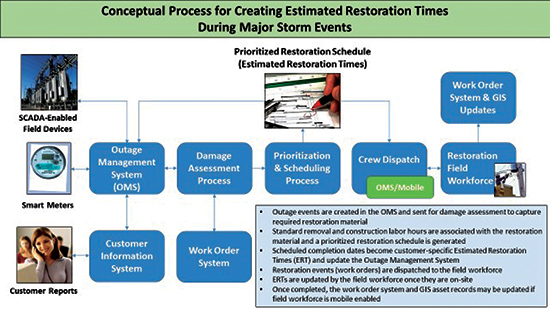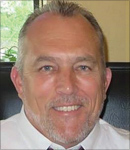Highlights from the BRIDGE Energy Group Utility Industry Survey on Outage and Restoration Management
For the past three years BRIDGE Energy Group has conducted its utility industry survey. Part of the survey examines outage and restoration management, and how utilities are using advanced technology to improve operational performance. This article takes a closer look at some of the ways that smart meters can add value for a utility’s outage and restoration management program.

Figure 1. BRIDGE’s outage and restoration management vision for leading utilities
Outage Notification
Recent survey results show that 81 percent of respondents have deployed smart meters for at least a portion of their customers. However, a closer look reveals that many utilities still rely on customer calls for outage notifications.
Table 1: Primary source of outage notification by weather conditions (Source: BRIDGE Energy Group)
| Primary Source of Outage Notification |
Customer Calls | Smart Meters |
| Blue Sky days | 58% | 16% |
| Storm day | 54% | 12% |
Making use of smart meter outage notifications requires good integration between the new metering technology, existing operational technology and IT. It’s also important for utilities to modify business processes to take advantage of the capabilities of the new technology. Meters are not inherently smart; but utilities can use them to improve operations, increase efficiency and drive customer satisfaction.
A common use case for smart metering is automatic outage notification. Some meters emit a notification when power is lost or restored. Making good use of this information depends on several factors:
- Power outage notifications (PONs) and power restoration notifications (PRNs) must be received in a timely manner to be processed by the OMS
- PONs should be received from enough meters to provide a good picture of an outage, and improve outage prediction in the OMS
- The reliability of a PON should be as good as a customer call
- A PON should indicate a problem on the utility power system that can be corrected by the utility
- The utility should be able to check the power status of a meter quickly, and reliably
A common problem is that a PON doesn’t always indicate a problem that needs fixing – this is known as a ‘false positive.’ False positives can obscure real outage information and make it harder for utilities to trust the information coming from smart meters. A simple integration between the AMI head-end system and the OMS can result in numerous false positives hitting the OMS. This can flood the OMS and make it difficult for operators to use the system to make decisions. When this happens, the outage business case from smart meters may be diminished.
A Two-Part Solution
Intelligent Filter: The intelligent filter removes false positives. These can be duplicate messages, messages from momentary interruptions from reclosing, or messages from voltage dips. This increases the probability that PONs sent to the OMS represent real outages that require attention from the operator.
Pinger: The ‘Pinger’ can send a message to a meter to check its status. If an outage message makes it through the filter but is still suspect, the Pinger can try to validate the outage. If the meter responds to the ping, the system knows that the power is on. If there is no response from the meter, the outage is passed on to the OMS for further analysis.
BC Hydro has designed such a solution. After implementation the utility found that 70 to 80 percent of unwanted outage messages from the meter head-end system were eliminated. This left a much smaller number of outage messages to be processed by operators in the OMS.
Outage Diagnosis
An OMS is a primary tool for this, along with supervisory control and data acquisition. Increasingly, Advanced Distribution Management Systems (ADMS) are being implemented along with distribution automation in the field. Capabilities such as Fault Location Isolation and Service Restoration (FLISR) promise to support a dramatic improvement in this area.
Managing Customer Expectations
Expectations of 21st century utility customers will be higher than ever before. Reliable electricity supports virtually all aspects of modern life, and access to information on demand from service providers is raising the bar for utilities. Providing timely and accurate information about outages and restoration is a critical opportunity. Customers expect utilities to:
- Know that the power is out, even if no one is home to call
- Tell them when power will be restored, and provide updates on progress
- Provide two-way communications options according to personal preference
Most customers realize the power will go off from time to time, especially during stormy weather. There are limits, however, to the frequency and duration of power outages that customers will endure.
Proactive Outage Notification
Smart meter information can be provided to customer service systems to proactively inform customers about their outage when they use the interactive voice response system (IVR), such as, “We know there is an outage in your area. The estimated restore time is…” Customer service representatives can also be given the ability to ‘ping’ a customer meter while the customer is on the phone in order to identify if the outage is on the customer or the utility side of the meter.
Increasingly, utilities are moving to other electronic means for notification. Text messaging and email are common options today. Many leading utilities have launched sophisticated programs for communicating with customers through social media channels such as Twitter and Facebook. These platforms are attractive because they enable large-scale two-way high speed and low cost communications.
Estimated Time to Restoration
Power quality and reliability are key drivers of overall customer satisfaction (J.D. Power). Moreover, timely and accurate information about the estimated time to restoration (ETR) can be a key piece of information, and a great opportunity to engage customers and build credibility and trust. Major storm events in the last few years have drawn attention to ETRs, and the importance of good estimation and timely reporting by utilities for their customers.
BRIDGE survey results indicate that there is room for improvement:
- Approximately one quarter of utilities are not calculating ETRs
- 22 percent are unhappy with the quality of the ETRs they are able to calculate
- 22 percent of respondents are dissatisfied with the quality of their Initial Damage Assessment (IDA)
Utilities provide ETRs based on a number of different variables, ranging from system averages, the time of year, type of weather, type of clearing device or some combination of these and other criteria. The processes for estimating ETRs is also widely disparate across utilities, even within the same state. After Hurricane Irene, the Public Service Commission of Maryland noted (in Order 84445) that ETR inaccuracy and inconsistency throughout the restoration calculation and communication process was a problem across all five utilities under its purview and ordered the utilities to align their ETR practices so as to better inform their customers of the status of their electric service.
ETRs created without knowledge of the actual condition of the grid and what is in need of repair to restore power, are more or less an educated guess. Providing accurate ETRs is premised on a timely and accurate damage assessment process. Several utilities are taking a more detailed look at the ETR process that involves utilizing technology in the damage assessment process and integrating the results with other enterprise systems, such as the OMS and work order systems. Figure 2 below is a conceptual diagram on this approach.

Figure 2: Integrated Damage Assessment
With this approach, restoration work is treated and scheduled like any other utility construction work. Damage assessment information is captured and enhanced with labor hours from the work order system and crew availability to create schedulable units of work that can be assigned to field restoration crews. ETRs are obtained from the estimated completion dates resulting from the prioritization and scheduling process, modified for any specific preferences such as end of day ETRs. These ETRs are then provided to the OMS and CIS systems and made available to customers.
Smart meters can also be used for monitoring of any service level agreements (SLA) that are related to the performance guarantees made by the vendor for the meters themselves. Such SLA measures as communication success rates, a percentage of PONs received relative to number of customers out in the OMS, missed meter reads or number of stale meters can be provided.
Leading Practices for Tech-Savvy Customers
As the tech-savvy customer more actively engages in online and social media platforms, they expect real-time information and updates. Not only do they want options for reporting outages and receiving restoration updates, they also want to receive alerts regarding their energy usage and the ability to conduct routine business such as paying their bill. And they want to do it through channels of their choosing during the times most convenient to them. Online web portals and mobile apps, for example, provide this flexibility and are becoming more available from utilities as they strive to meet the needs of the tech-savvy customer.
Regardless of where a utility falls on the ORM continuum, Outage and Restoration Management is complex. From the time the power goes out to the time power is restored, numerous business processes and enabling technologies are involved. Improving operational performance starts with applying technology at key points along the end-to-end outage management process that yield shorter outages, lower restoration costs and higher customer satisfaction. That’s a meaningful return for the utility and its customers.
About the Authors
 Scott Grafelman is Principal Consultant at BRIDGE Energy Group. Scott has over 31 years of progressive leadership responsibility in the electric utility industry in the areas of distribution operations and restoration; distribution engineering, long-range planning, automation and asset management; project management; distribution, substation and transmission construction and maintenance; distribution design; customer service; community affairs and energy management.
Scott Grafelman is Principal Consultant at BRIDGE Energy Group. Scott has over 31 years of progressive leadership responsibility in the electric utility industry in the areas of distribution operations and restoration; distribution engineering, long-range planning, automation and asset management; project management; distribution, substation and transmission construction and maintenance; distribution design; customer service; community affairs and energy management.
 Forrest Small is Vice President of Grid Optimization Strategy for BRIDGE Energy Group. He leads the company’s Grid Reliability practice focusing on grid operations technology and process improvement. He specializes in modern grid strategy and planning, and is working closely with utilities in grid modernization and transformation programs across North America. Forrest is a licensed professional engineer with twenty-five years of combined experience in management consulting, and T&D planning and operations at an electric utility.
Forrest Small is Vice President of Grid Optimization Strategy for BRIDGE Energy Group. He leads the company’s Grid Reliability practice focusing on grid operations technology and process improvement. He specializes in modern grid strategy and planning, and is working closely with utilities in grid modernization and transformation programs across North America. Forrest is a licensed professional engineer with twenty-five years of combined experience in management consulting, and T&D planning and operations at an electric utility.







